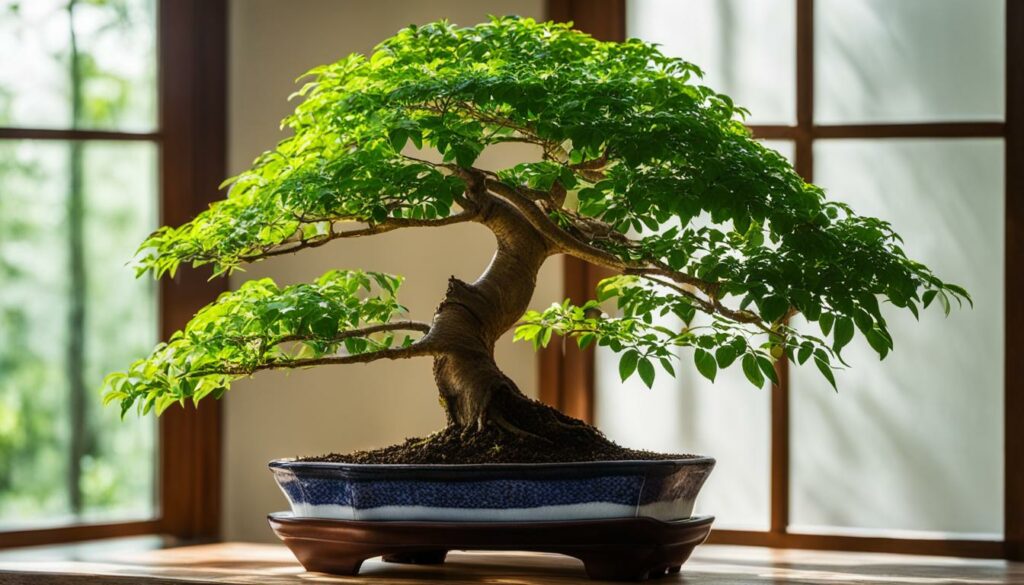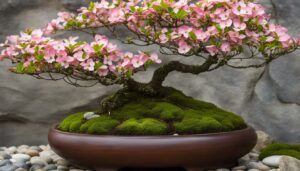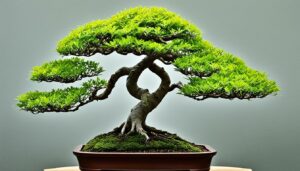Looking for a unique and captivating bonsai tree species? Allow us to introduce you to the Brazilian Rain Tree bonsai. This tropical indoor bonsai features a distinctive leaf structure, bark, and overall appearance that makes it stand out from other bonsai trees. Keep reading to learn more about this captivating bonsai species.
Key Takeaways:
- Brazilian Rain Tree bonsai is a unique and captivating species
- As a tropical indoor species, it requires specific growing conditions and care
- Brazilian Rain Tree bonsai is an ideal choice for beginners in the world of bonsai
- Training techniques can be used to shape and style this species into stunning bonsai designs
- The Brazilian Rain Tree bonsai is a symbol of tropical elegance and connection with nature
An Introduction to the Brazilian Rain Tree Bonsai
If you are a fan of bonsai trees, the Brazilian Rain Tree bonsai is undoubtedly a species you’ll want to know about. With its botanical name, Pithecellobium bonsai, this tropical bonsai is a perfect choice for indoor enthusiasts looking to add a touch of nature to their living spaces.
The Brazilian Rain Tree is a stunning indoor bonsai with delicate foliage, intricate bonsai trunk, and a lovely canopy. Its leaves feature tiny leaflets that close up at night, only to re-open in the morning, making it a fascinating bonsai tree to watch.
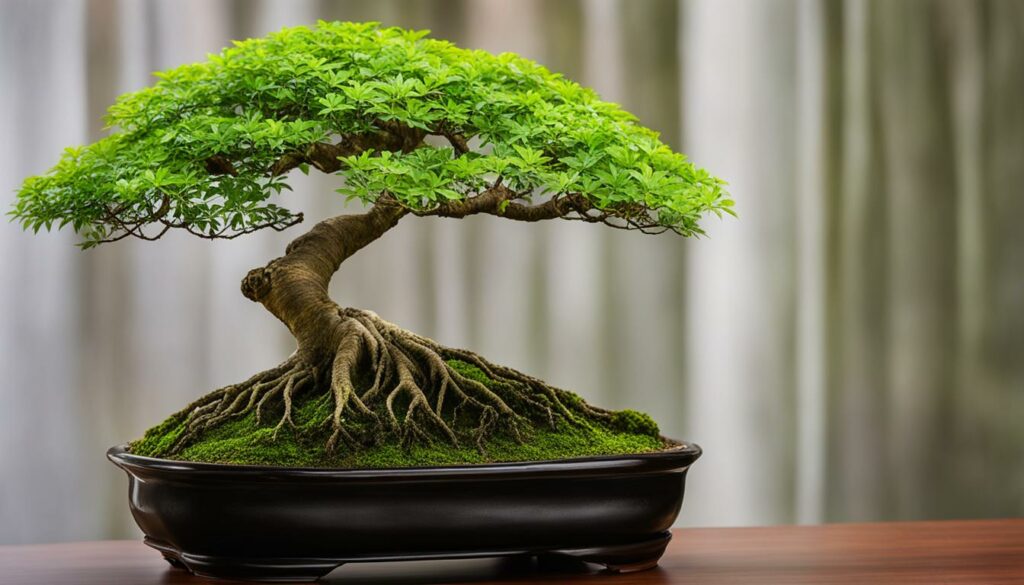
Moreover, this tropical bonsai’s adaptability to different indoor conditions makes it an increasingly popular choice among indoor gardeners. Its unique resilience to lower light levels makes it an ideal plant for various indoor settings under fluorescent lights. Its ability to tolerate dry conditions also makes it a practical plant for those who are forgetful or busy.
“The Brazilian Rain Tree Bonsai is a fascinating plant, and its ability to adapt to various indoor conditions make it an increasingly popular choice among indoor gardeners.”
What’s more, the Brazilian Rain Tree bonsai boasts an array of beautiful colors. During the spring and summer months, its canopy features lush greenery and white flowers. In contrast, fall and winter see the leaves shimmer into a beautiful array of colors ranging from yellows to oranges, to reds and purples, making it an ever-changing, visually-appealing indoor bonsai.
Now that you know a bit about this unique tropical indoor bonsai, let’s dive into its features and characteristics in the following section.
Characteristics of the Brazilian Rain Tree Bonsai
One of the most striking features of the Brazilian Rain Tree bonsai is its unique leaf structure. The leaves are bipinnate, meaning that they have many small leaflets arranged on either side of the stem. This gives the leaves a delicate and intricate appearance, adding to the tree’s overall beauty. The bark of the Brazilian Rain Tree is also distinctive and provides an interesting texture and color contrast to the tree’s leaves.
Additionally, the Brazilian Rain Tree bonsai has an overall appearance that captivates the senses. The tree features a graceful, yet sturdy trunk that supports its lush crown. The crown is comprised of many small branches that produce a profusion of delicate foliage. Together, these characteristics make the Brazilian Rain Tree bonsai a truly impressive and visually appealing plant.
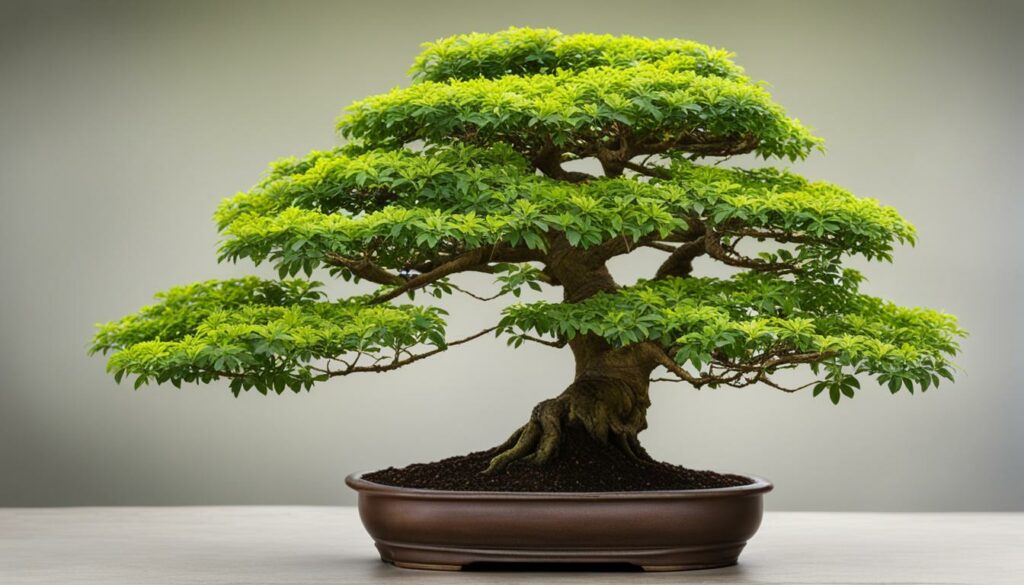
In fact, Brazilian Rain Tree is known for its unique and compelling beauty, which makes it a popular choice among bonsai enthusiasts. Its distinct features and stunning appearance make it a must-have for anyone looking to add a touch of tropical elegance to their indoor space.
Growing and Care Tips for Brazilian Rain Tree Bonsai
With its tropical nature, the Brazilian Rain Tree bonsai is an ideal choice for indoor bonsai enthusiasts. Here are some practical growing and care tips to ensure the health and vitality of your Brazilian Rain Tree bonsai:
- Position: Place your Brazilian Rain Tree bonsai in a brightly lit area away from direct sunlight.
- Watering: Water your bonsai thoroughly, keeping the soil moist but not waterlogged. Watering frequency may vary depending on the seasons and climate.
- Fertilization: Fertilize your Brazilian Rain Tree bonsai every four weeks during the growing season with a balanced fertilizer.
- Pruning: Prune your bonsai regularly to maintain its shape and promote new growth.
- Repotting: Repot your Brazilian Rain Tree bonsai every two to three years, using a well-draining soil mix.
Follow these tips to ensure your Brazilian Rain Tree bonsai thrives and adds tropical beauty to your indoor space.
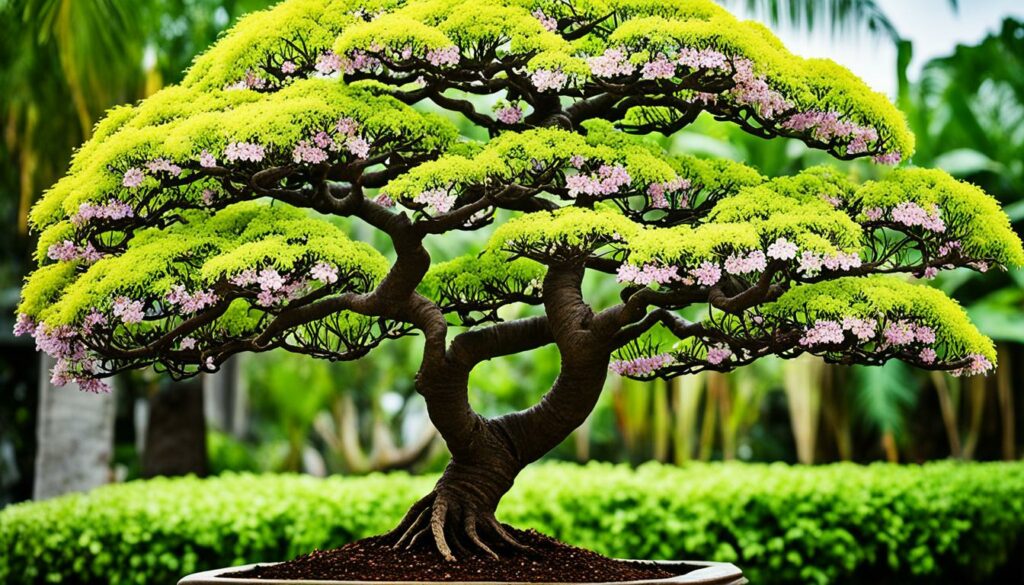
Training Techniques for Brazilian Rain Tree Bonsai
Shaping and styling Brazilian Rain Tree bonsai is an art form, and there are several techniques you can use to create stunning designs. Here are some of the most effective methods:
Pruning
Pruning is a crucial technique that involves cutting back branches and foliage to shape and balance your bonsai tree’s growth. To prune your Brazilian Rain Tree bonsai, use sharp, clean shears and make precise cuts at a 45-degree angle. Avoid removing more than one-third of the tree’s foliage at any given time, as this can stunt its growth.
Wiring
Wiring is a technique that allows you to bend and shape your bonsai tree’s branches into the desired position. To wire your Brazilian Rain Tree bonsai, wrap thin, flexible wire around the branches and gently shape them into the desired form. Leave the wire on for a few months until the tree has set into the desired shape, then remove it carefully.
Branch Manipulation
Branch manipulation is a technique used to adjust the angle and direction of your bonsai’s branches to complement its overall design. To manipulate your Brazilian Rain Tree bonsai’s branches, you can use weights or clamps to pull or push them in the desired direction gradually.
Implementing these training techniques requires patience, care, and attention to detail. By combining them, you can create unique and stunning designs that showcase the beauty of this tropical bonsai species.
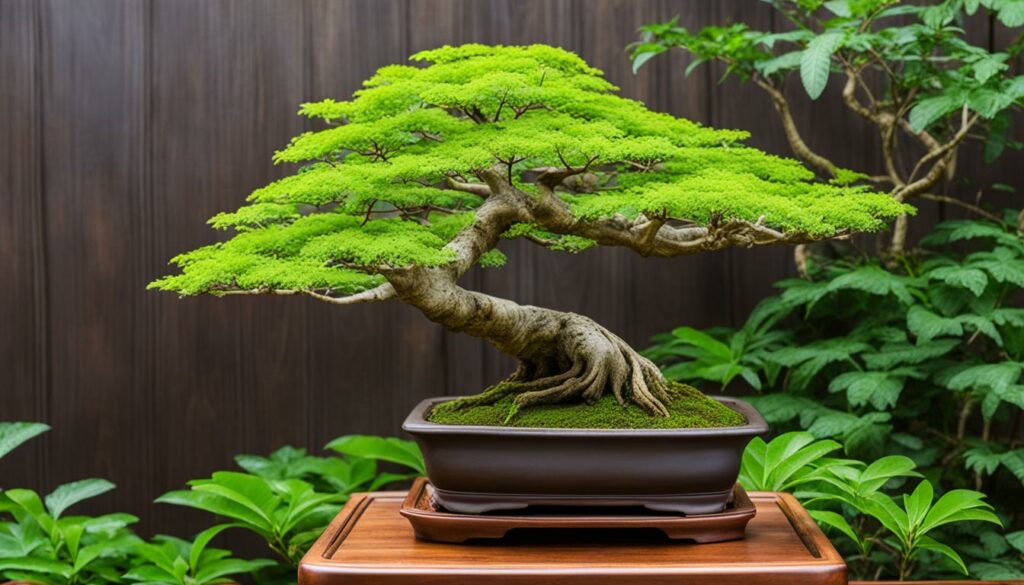
Showcasing Brazilian Rain Tree Bonsai Styles
With its unique beauty and tropical nature, the Brazilian Rain Tree is a popular choice among bonsai enthusiasts. In this section, we showcase various bonsai styles that perfectly complement the Brazilian Rain Tree species.
Traditional styles, such as the formal upright and the slanting style, showcase the Brazilian Rain Tree’s elegant trunk and branches. The informal upright style accentuates the tree’s natural growth pattern, while the cascading style creates a dramatic effect.
Contemporary styles, such as the windswept and the broom style, offer creative interpretations of the Brazilian Rain Tree bonsai. The windswept style emphasizes the tree’s resilience in the face of strong winds, while the broom style showcases its dense foliage and compact growth.
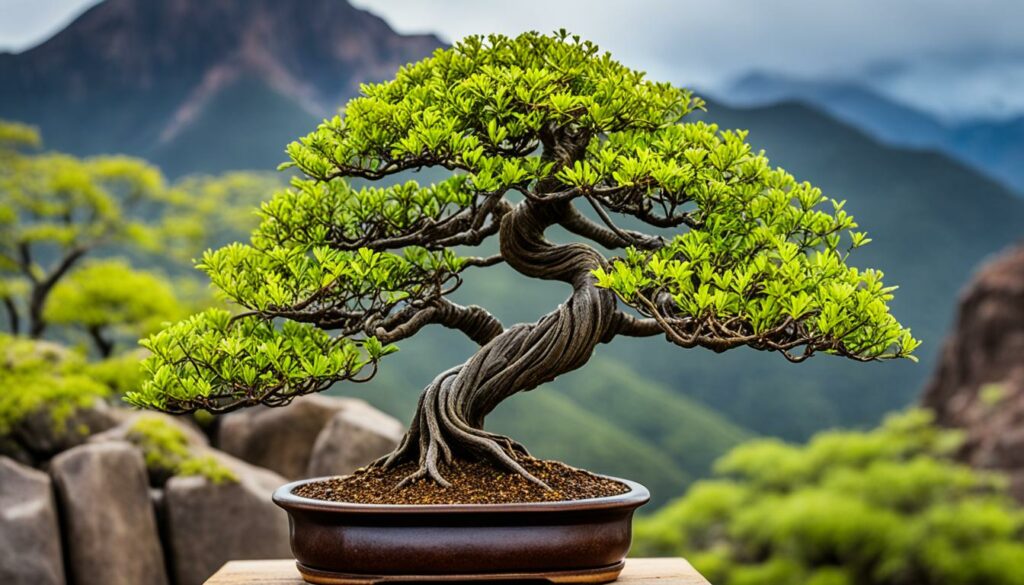
Tip: When selecting a bonsai style for your Brazilian Rain Tree, consider its unique characteristics, such as its leaf structure and bark, to create a visually stunning display.
Brazilian Rain Tree Bonsai: A Symbol of Tropical Elegance
When you think of the Brazilian Rain Tree bonsai, the first thing that comes to mind is its captivating beauty. But this tropical bonsai offers much more than just aesthetic appeal. It is a symbol of elegance, tranquility, and a profound connection with nature. As an indoor bonsai, the Brazilian Rain Tree species can transform any space into a tropical paradise, filling it with warmth and life.
Its unique features are compelling: the graceful, fern-like foliage, the rugged, gnarled bark, and the delicate white flowers. Just one glance at this beautiful plant evokes a sense of tranquility and balance. As you display this bonsai tree in your indoor space, you’ll soon discover its ability to create a calming, peaceful environment. It’s an effortless way to bring a touch of the tropics into your home or office.
Another reason why the Brazilian Rain Tree bonsai is such a popular choice among indoor bonsai enthusiasts is its adaptability. This tropical bonsai species thrives with minimal care and attention, making it a perfect choice for beginners. With proper growing conditions, watering, and pruning techniques, your Brazilian Rain Tree bonsai can flourish and grow for many years to come.
Whether you’re an experienced bonsai enthusiast or a beginner, the Brazilian Rain Tree bonsai is an excellent choice. Its remarkable beauty, symbolism, and resilience make it a cherished species among bonsai collectors. So why not add a touch of tropical elegance to your indoor space with this exceptional bonsai tree?
Brazilian Rain Tree Bonsai: Troubleshooting and Common Issues
If you’re a proud owner of an indoor Brazilian Rain Tree bonsai, you may come across some common issues while caring for it. However, with some knowledge of troubleshooting techniques, you can ensure the health and vitality of your bonsai.
Diseases: Fungal and bacterial infections are common among indoor bonsais, including the Brazilian Rain Tree. Keep an eye out for yellowed or brown leaves, spots, or discolored flowers. To treat, prune the diseased parts and use a fungicide or bactericide.
Pests: Spider mites, mealybugs, and aphids can harm your Brazilian Rain Tree bonsai. Remove the bugs by hand or use insecticidal soap or neem oil. Keep the area surrounding your bonsai clean and free of debris to prevent the spread of pests.
Overwatering: Brazilian Rain Tree bonsais require a moderate amount of water, but overwatering can lead to root rot and eventually kill the plant. Allow the soil to partially dry between waterings, and never water the plant when the soil feels moist.
Underwatering: too little water can also harm the Brazilian Rain Tree bonsai, causing leaves to turn brown or fall off. Make sure the soil is moist to the touch, but not overly saturated.
Lighting: inadequate lighting can cause stunted growth or leaf drop in the Brazilian Rain Tree bonsai. Make sure your bonsai is placed in a well-lit area, away from direct sunlight that can damage its leaves.
By taking steps to prevent and address these common issues, you can ensure the health and longevity of your prized Brazilian Rain Tree bonsai.
The Brazilian Rain Tree Bonsai: An Ideal Choice for Beginners
If you’re new to the world of bonsai, the Brazilian Rain Tree bonsai is an excellent choice to start with. Its resilience and hardiness make it a forgiving species to work with, making it ideal for beginners.
This tropical bonsai species is also well-suited to indoor environments, adding natural beauty to your living space. Its adaptability to a range of growing conditions means it can thrive in different environments and climates, making it a go-to choice for indoor bonsai enthusiasts.
The Brazilian Rain Tree bonsai requires minimal maintenance, meaning you won’t need to spend an excessive amount of time caring for it. Additionally, it’s able to withstand occasional under or over-watering, making it easier to care for than some other species.
If you’re getting started with bonsai, the Brazilian Rain Tree is an ideal choice that will provide you with a gorgeous and rewarding indoor bonsai experience.
Brazilian Rain Tree Bonsai: Adding Tropical Beauty to Your Indoor Space
Bringing a Brazilian Rain Tree bonsai into your indoor space is a perfect way to add a touch of tropical elegance. With their unique foliage and bark, these tropical bonsais can transform any room into a tranquil paradise.
When it comes to displaying your Brazilian Rain Tree bonsai, there are various containers and stands to choose from. Consider the overall aesthetic of your space and choose a display option that complements your interior design.
You can even take your display to the next level by creating a miniature indoor garden with other tropical species. Your Brazilian Rain Tree bonsai will thrive in an environment with other humidity-loving plants and create an eye-catching display.
Overall, including a Brazilian Rain Tree bonsai in your indoor space brings exotic beauty and calming energy to your home or office. With proper care and attention, your indoor bonsai will become a cherished highlight of your decor.
Conclusion
Congratulations on completing this in-depth look at the unique Brazilian Rain Tree bonsai species. You now have a better understanding of its tropical nature, captivating beauty, and low maintenance requirements that make it an excellent choice for indoor bonsai enthusiasts.
Remember, providing your Brazilian Rain Tree bonsai with ideal growing conditions and taking proper care will ensure its health and vitality. Whether you’re a seasoned bonsai grower or a beginner, the Brazilian Rain Tree bonsai is a symbol of tropical elegance that will add stunning beauty to your indoor space.
So, what are you waiting for? Get your hands on a Brazilian Rain Tree bonsai and start exploring the world of tropical bonsai today!
FAQ
What is the Brazilian Rain Tree bonsai?
The Brazilian Rain Tree bonsai, scientifically known as Pithecellobium bonsai, is a tropical bonsai species that is popular among indoor bonsai enthusiasts. Its unique characteristics and captivating beauty make it a prized choice for bonsai enthusiasts.
What are the key characteristics of the Brazilian Rain Tree bonsai?
The Brazilian Rain Tree bonsai features a distinctive leaf structure, with small, compound leaves that create an elegant and lush foliage. It also showcases an interesting bark, which adds to its overall beauty.
How do I grow and care for a Brazilian Rain Tree bonsai?
To grow and care for a Brazilian Rain Tree bonsai, it is essential to provide it with a tropical environment. This includes placing it in a well-lit area with indirect sunlight, maintaining proper watering and fertilization, and periodically pruning and repotting it to ensure its health and vitality.
What training techniques can I use for shaping the Brazilian Rain Tree bonsai?
Training techniques such as pruning, wiring, and branch manipulation are suitable for shaping and styling the Brazilian Rain Tree bonsai. These techniques allow you to create unique designs and enhance the overall aesthetics of your bonsai tree.
What are some popular bonsai styles that complement the Brazilian Rain Tree bonsai?
The Brazilian Rain Tree bonsai can be showcased in various traditional and contemporary bonsai styles. These include formal upright style, cascading style, slanting style, and forest style. Each style accentuates the natural beauty and elegance of this tropical bonsai species.
What does the Brazilian Rain Tree bonsai symbolize?
The Brazilian Rain Tree bonsai symbolizes tropical elegance, tranquility, and a connection with nature. Its graceful foliage and captivating appearance evoke a sense of serenity and beauty, making it a cherished choice among bonsai enthusiasts.
What are some common issues faced by Brazilian Rain Tree bonsai owners?
Like any other bonsai tree, Brazilian Rain Tree bonsai can face common issues such as diseases, pests, and root rot. It is important to regularly inspect your bonsai tree for any signs of trouble and take appropriate measures to address them promptly.
Is the Brazilian Rain Tree bonsai suitable for beginners?
Yes, the Brazilian Rain Tree bonsai is an ideal choice for beginners. It possesses resilience, requires low maintenance, and adapts well to different environments. Its forgiving nature allows beginners to learn and experiment with bonsai techniques while still enjoying the beauty of this tropical bonsai species.
How can I incorporate the Brazilian Rain Tree bonsai into my indoor space?
To add tropical beauty to your indoor space, consider displaying your Brazilian Rain Tree bonsai in suitable containers and stands. This will enhance its overall aesthetic appeal and create a tranquil atmosphere reminiscent of a tropical paradise.
